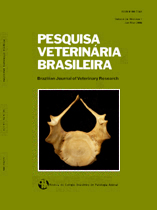 |
|
|
|
Year 2010 - Volume 30, Number 6
|

|
Congenital bone defects in Guiana dolphin, Sotalia guianensis (Mammalia, Cetacea, Delphinidae) in the north-central coast of Rio de Janeiro state, Brazil, 30(6):484-490
|
ABSTRACT.- Laeta M., Souza S.M.F.M. & Siciliano S. 2010. [Congenital bone defects in Guiana dolphin, Sotalia guianensis (Mammalia, Cetacea, Delphinidae) in the north-central coast of Rio de Janeiro state, Brazil.] Anomalias ósseas congênitas em Sotalia guianensis (Mammalia, Cetacea, Delphinidae) da costa centro-norte do estado do Rio de Janeiro. Pesquisa Veterinária Brasileira 30(6):484-490. Departamento de Endemias Samuel Pessoa, Escola Nacional de Saúde Pública Sergio Arouca/Fiocruz, Rua Leopoldo Bulhões 1480, Manguinhos, Rio de Janeiro, RJ 21041-210, Brazil. E-mail: mairalaeta@gmail.com
Carcasses of Guiana dolphins, Sotalia guianensis (van Bénéden, 1864) were recovered from August 20, 2001 to February 13, 2006 along the north-central coast of Rio de Janeiro state. Most of the animals (85%) were found between Barra de São João (22°35’S 41°59’W) and Quissamã (22°06’S 41°28’W). We studied the vertebral columns of all the 20 specimens that had more than 60% of the vertebrae preserved. The series has 75% of immature animals and all skeletons displayed a minimum of taphonomic changes. Two categories of congenital anomalies were diagnosed, both related to the development of the paraxial mesoderm. The seventh cervical vertebra (C7) was the only affected; the cervical ribs and the cleft neural arches were present in 15 (75%) of the individuals, three (15%) of which had both anomalies. Nine (45%) individuals had unilateral or bilateral cervical ribs, and nine (45%) individuals had cleft neural arches; the contiguous vertebrae were normal in every case. The frequency of these anomalies was higher in that Rio de Janeiro series than in other Sotalia series previously reported in the Brazilian literature for Amazonas, Ceará and Santa Catarina States. The present Sotalia series here described comes from a very limited coastal region probably representing a local population. The cervical ribs are genetically defined and may be concentrated because of a condition of close biological proximity among the animals; the cleft arch could also be determined by environmental factors, to be investigated in the future. |
| |
|
|
| |
|
 |